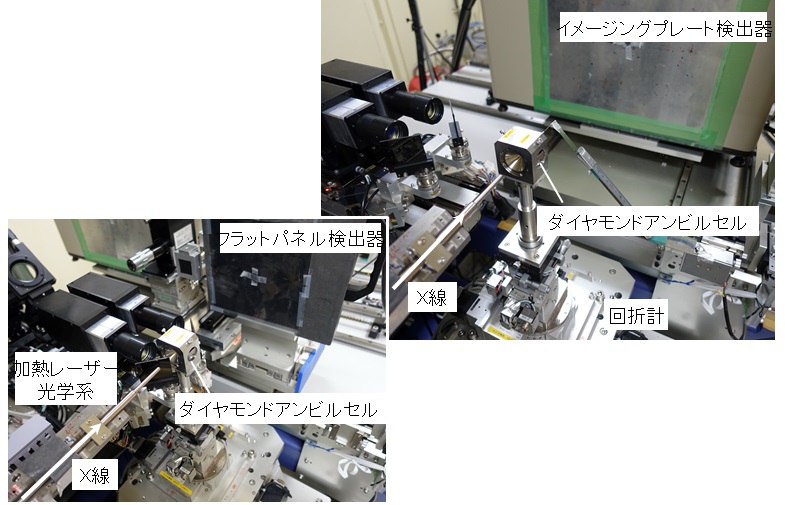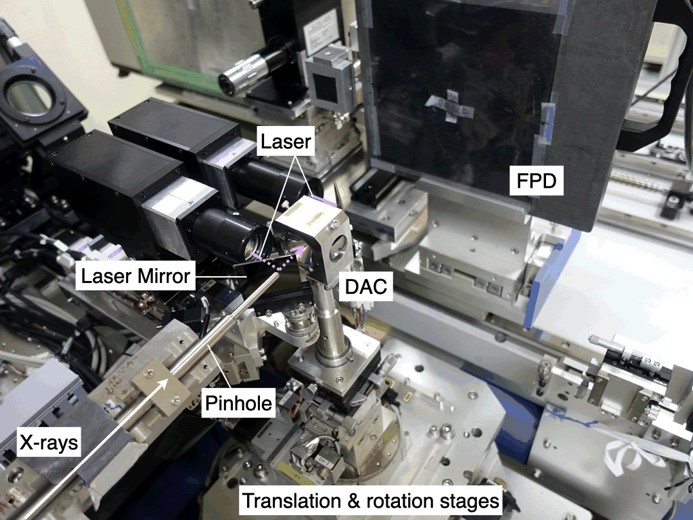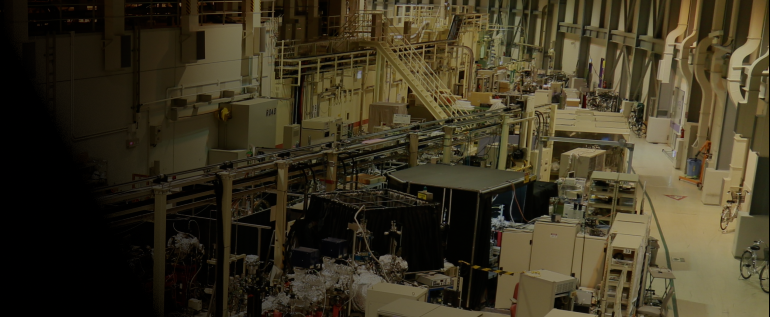高圧マイクロX線回折装置
◆装置概要
本装置は,各種ダイヤモンドアンビルセル高圧装置を搭載できる多目的X線回折計です.オンライン両面レーザー加熱システムを備え,X線二次元検出器としてイメージングプレートとフラットパネルを使用することが可能です.


◆装置の特徴
回折計本装置は,シンメトリー型,箱型,レバー型など各種ダイヤモンドアンビルセル高圧装置(Diamond anvil cell, DAC)を搭載可能なX線回折計です.高耐荷重精密XYZステージと高精度1軸回転ステージから構成されており,高圧試料は精密可動ステージにより回折計の回転中心に合わせることができます.回転中心精度(偏心)は数ミクロン以下となっています.本回折計では,オンライン両面レーザー加熱光学システムとの組み合わせが可能となっている他,抵抗加熱用真空チャンバや重量のある冷凍機を搭載することもできます.
オンライン両面レーザー加熱光学システムによる高温高圧X線回折計測
検出器
イメージングプレート(IP)X線検出器:
大面積で,広いダイナミックレンジを有し,測定可能なX線エネルギー範囲が広いという特長を持つ検出器です.主に,広い逆格子空間の観測と正確な回折線強度データの取得が要求される精密な結晶構造解析に使用されます.測定時における試料と検出器間のカメラ長は,測定角度範囲と角度分解能に応じて,200~450 mmの範囲で移動可能です.カメラ長450 mmで使用時は,角度分解能が0.013度となります.検出器のカメラ長を200 mmとし,水平方向にオフセットした場合,観察可能な回折角を45度以上に拡張することができます.IP検出器は,リガク社製R-AXIS IV++で,面積300×300 mm2、読み取り分解能0.10 mm, ダイナミックレンジ20bitとなっています.
フラットパネルX線検出器(FPD):
本検出器は,CsI: Tlが直接蒸着された高エネルギーX線対応の二次元検出器です.二次元回折像の高速読み出しが可能で,時間分解を必要とする測定やリアルタイムのモニタリングにも利用されます.測定時における試料と検出器間のカメラ長は,200~430 mmの範囲で移動可能です.FPDは,Perkin Elmer社製XRD0822 CP23で,1024×1024ピクセル、ピクセルピッチ0.20 mm, ダイナミックレンジ16bit, フレームレート最大25 fpsとなっています.
制御ソフトウエア
IP検出器の制御は,(株)リガクにより開発された専用ソフトウエアを使用しています.FPD検出器は,ナショナルインスツルメンツ社製LabVIEWでプログラミングされた計測ソフトウエアから操作しています.各種ステージは,ツジ電子ステッピングモーターコントローラPM16Cによる機器制御を基本とし,VBまたはLabVIEWでプログラミングされたソフトウエアにより操作しています.
使用可能エネルギー領域: 14.4~61 keV
エネルギー分解能: ΔE/E~10-4
ビームサイズ: φ0.01~1.0 mm (FWHM)
試料位置でのビーム強度: 1×1011 photons/sec (30 keV, ビームサイズφ0.01 mm), 5×1010 photons/sec (61 keV, ビームサイズφ0.01 mm)
◆装置アクセサリー
オンライン両面加熱レーザー光学システム
・水冷式連続発振100 Wファイバーレーザー(SPI,1070 nm): 2台
・フラットトップビーム整形光学系
・試料位置レーザー径:10~40ミクロン(可変)
・温度領域:1500~6000 K
オンラインラマン散乱分光装置
・励起光源:CW(連続)発振DPSSレーザー532 nm (50 mW), CW発振ダイオードレーザー632.8 nm (50 mW)
・分光器:Teledyne Princeton Instruments SP2500i
・グレーティング:1200 gr/mm, 1800 gr/mm,f = 500 mm
・検出器:電子冷却機構CCD(Teledyne Princeton Instruments PIXIS)
・制御・測定ソフトウェア:Teledyne Princeton Instruments LightField
・共焦点ラマンプローブユニット(対物レンズ: ×20,WD26.6 mm)
極低温冷凍機システム
・4K GM冷凍機
・温度領域(DAC試料位置):10~300 K
・最低温度到達時間:120分
・四端子法による電気抵抗測定で必要な信号線(リード線)が利用可能
◆実験・試料準備
・室温下での高圧実験では,シンメトリー型(外径48mm)および箱型(50×50×55mm)ダイヤモンドアンビルセル装置(DAC)の利用を基本としています.その他形状のDACを持ち込んで実験を実施する際は,事前にご相談ください.
・両面レーザー加熱光学システムを利用した高温高圧X線回折では,シンメトリー型DAC(外径48mm,長さ36mm)による実験を基本としています.
・ダイヤモンドアンビル受け台の開口部の角度は,X線の波長と回折角の測定範囲,及びレーザー照射サイズを考慮し,選択して下さい.
・高温高圧実験における試料封入用ガスケット材として,レニウムまたはタングステンで準備して下さい.高温下でじん性が低下するステンレス鋼は不向きです.
・ガスケット材への穴開け加工(きれいにバリ取りが必要)
・圧力マーカーとしてのルビー(Al2O3: Cr3+)を試料室に充填する際,実験ハッチ2では検出器側のアンビル先端にルビーの小粒をセットして下さい.
・ビームラインに整備されているダイヤモンドアンビルセル高圧装置を利用希望の場合,ヘリウム圧力媒体を使用した準静水圧下での実験や,試料準備にグローブボックスの利用が必要な場合,事前にご相談下さい.
◆実験手順・注意事項
基本的実験手順
・標準物質による入射X線波長およびカメラ長(試料と検出器間距離)の決定
・出発物質のX線回折(XRD)パターン確認後,ダイヤモンドアンビルセル(DAC)への試料封入(オプションとして,ヘリウムなど圧力媒体用高圧ガス充填,グローブボックスの使用)
・DAC試料室の圧力測定(ルビー蛍光法,ダイヤモンドラマン法,またはXRD)
・レーザー加熱による高温高圧実験の場合,加熱レーザー調整(レーザー照射位置調整,レーザー光学系によるDAC内試料の観察)
・DAC内試料のX線照射位置への移動(DAC内試料位置とX線照射位置,加熱レーザー照射位置の各光軸の一致調整)
・目的の温度圧力でのXRD計測(レーザーパワー調整,温度測定)
注意事項
・レーザー加熱光学システムおよび冷凍機システムを使用希望の場合,事前にご相談ください.整備している冷凍機に搭載可能な高圧装置として,DiacellⓇBragg-LT型CuBe製DACの使用を基本としています.但し,外観サイズ(固定用ネジ位置も含めます)が同じDACであれば,冷凍機への組み込みは可能です.
・DACで使用しているダイヤモンドアンビルは,高荷重下での加圧時やレーザー加熱中に破壊されることがあります.
◆問い合わせ先
平尾 直久 (このメールアドレスはスパムボットから保護されています。閲覧するにはJavaScriptを有効にする必要があります。)
河口 沙織 (このメールアドレスはスパムボットから保護されています。閲覧するにはJavaScriptを有効にする必要があります。)
大石 泰生 (このメールアドレスはスパムボットから保護されています。閲覧するにはJavaScriptを有効にする必要があります。)
◆代表的な論文リスト
Equation of state of liquid iron under extreme conditions
Y. Kuwayama, G. Morard, Y. Nakajima, K. Hirose, A. Q. R. Baron, S. I. Kawaguchi, T. Tsuchiya, D. Ishikawa, N. Hirao, Y. Ohishi
Physical Review Letters, 124, (2020) 165701.
DOI: 10.1103/PhysRevLett.124.165701
Formation of H2-rich Iodine-Hydrogen Compounds at High Pressure
J. Binns, P. Dalladay-Simpson, M. Wang, G. J. Ackland, E. Gregoryanz, R. T. Howie
Physical Review B, 97, (2018) 024111.
DOI : 10.1103/PhysRevB.97.024111
Experimental Determination of the Electrical Resistivity of Iron at Earth’s Core Condition
K. Ohta, Y. Kuwayama, K. Hirose, K. Shimizu, Y. Ohishi
Nature, 534, (2016) 95-98.
DOI : 10.1038/nature17957
High-Pressure Generation using Double Stage Micro-Paired Diamond Anvils Shaped by Focused Ion Beam
T. Sakai, T. Yagi, H. Ohfuji, T. Irifune, Y. Ohishi, N. Hirao, Y. Suzuki, Y. Kuroda, T. Asakawa, T. Kanemura
Review of Scientific Instruments, 86, (2015) 033905.
DOI : 10.1063/1.4914844
Equation of state of bcc-Mo by static volume compression to 410 GPa
Y. Akahama, N. Hirao, Y. Ohishi, A. K. Singh
Journal of Applied Physics, 116 (2014) 223504.
DOI: 10.1063/1.4903940
High-Pressure Micro X-Ray Diffraction Equipment
◆Equipment overview
This equipment is a multi-purpose X-ray diffractometer that can be equipped with various high-pressure, diamond anvil cells. It is prepared with an online double-sided laser heating system, which allows the use of an imaging plate and a flat panel detector as two-dimensional X-ray detectors.


◆Features of the Equipment
DiffractometerThis equipment is a X-ray diffractometer that can be equipped with various diamond anvil cell diffraction devices (Diamond Anvil Cell, DAC) such as symmetry-type devices, box-type devices, lever-type devices, etc. It consists of a high-load-bearing, precision XYZ stage and a high-accuracy single-axis rotation stage. High-pressure samples can be matched to the center of rotation of the diffractometer by a precision movement stage. The precision of the center of rotation (eccentricity) is less than a few microns. The diffractometer can be combined with an online double-sided laser heating optical system, and can also be equipped with a resistance heating vacuum chamber and a heavy freezer.
High-temperature, high-pressure X-ray diffractometer measurement are completed by an online double-sided laser heating optical system.
Detector
Imaging Plate X-Ray Detector:
This is a detector with a large area and wide dynamic range, with a wide measurable X-ray energy range. It is mainly used for precise crystal structure analysis which is acquired through observation of wide reciprocal lattice space and diffraction line strength data. The camera length between the sample and the detector during the measurement can be moved within the range 200 to 450mm, depending on the measurement angle range and angular resolution. When a camera length of 450mm is used, the angular resolution is 0.013 degrees. If the camera length of the detector is set to 200mm and offset horizontally, the observable diffraction angle can be extended to 45 degrees or more. The IP detector is called R-AXIS IV++, and is manufactured by Rigaku, and it has an area of 300×300 mm2, a reading resolution of 0.10mm, and a dynamic range of 20bits.
Flat Panel X-Ray Detector (FPD):
This detector is a 2-dimensional detector with directly deposited CsI: Tl for high-energy X-rays. High-speed readouts of the 2-dimensional diffraction images is possible, and it is also used for time-resolution measurements and real-time monitoring. The camera length between the sample and the detector during the measurement has a movement range between 200 and 430mm. FPD is an XRD0822 CP23 manufactured by Perkin Elmer, with 1024×1024 pixels, a pixel pitch of 0.20mm, a dynamic range of 16bits and a maximum frame rate of 25fps.
Control Software
Control of the IP detector uses dedicated software which was developed by Rigaku. The FPD detector is operated by measurement software programmed by LabVIEW, which is manufactured by National Instruments. Various stages are operated by software programmed with VB or LabVIEW based on equipment control Tsuji Electronics steppe motor controller PM16C.
Available Electric Field: 14.4~61 keV
Energy Resolution: ΔE/E~10-4
Beam Size: φ0.01~1.0 mm (FWHM)
Beam Intensity at Sample Position: : 1×1011 photons/sec (30 keV, Beam Size φ0.01 mm), 5×1010 photons/sec (61 keV, Beam Size φ0.01 mm)
◆Equipment accessories
Online double-sided heating laser optical systems
・Water-cooled continuous wave 100W Fiber Laser(SPI,1070 nm): 2 units
・Flat-top Beam Smoothing Optical Systems
・Sample Position Laser diameter: 10~40 Microns (variable)
・Temperature Range: 1500~6000 K
Online Raman Scattering Spectrometer
・Excitation Light Source: CW (continuous) oscillating DPSS laser 532 nm (50 mW), CW oscillating diode laser 632.8 nm (50 mW)
・Splitter: Teledyne Princeton Instruments SP2500i
・Grating: 1200 gr/mm, 1800 gr/mm,f = 500 mm
・Detector: Electric Cooling mechanism CCD (Teledyne Princeton Instruments PIXIS)
・Control and Measurement Software: Teledyne Princeton Instruments LightField
・Confocal Focus Raman Probe Unit (Object Lens: ×20,WD26.6 mm)
Cryogenic Refrigerator Systems
・4K GM Freezer
・Temperature Range (DAC Sample Position):10~300 K
・Minimum Temperature Arrival Time: 120 Minutes
・The four-terminal method can be used with necessary electrical resistance measurements from the signal wire (lead wire)
◆Experiment / sample preparation
・Room temperature high-pressure experiments are based on the use of symmetric (outer diameter 48mm), and box type (50x50x55mm) diamond anvil cell devices (DAC). Please contact us in advance when bringing in other shaped DACs to conduct experiments.
・The double-sided laser heating optical system uses high-temperature, high-pressure X-ray diffraction in experiments with symmetric DACs (outer diameter 48mm, length 36mm).
・The aperture opening angle of the diamond anvil should be selected in consideration of the X-ray wavelength and the measurement range of the diffraction angle, as well as the laser irradiation size.
・During high-temperature, high-pressure experiments, the sample encapsulation gasket should be prepared with Rhenium or Tungsten. Stainless steel with reduced toughness under high temperatures is not suitable.
・ Drill into gasket material (De-burring is necessary)
・ When filling the sample chamber with rubies(Al2O3: Cr3+)as pressure markers, set a grain of ruby at the anvil tip on the detector side in experiment hatch 2.
・ If you wish to use the diamond anvil cell high-pressure device which is installed in the beamline, please contact us in advance, as it is necessary to use the glovebox for experiments under quasi-hydrostatic pressure using a Helium pressure medium.
◆Experimental procedure / precautions
Basic Experimental Procedures
・Using standard substances, determine the incident X-ray wavelength and camera length (distance between the sample and the detector).
・After reviewing the X-ray diffraction (XRD) pattern from the departure substance, enclose the sample in the diamond anvil cell (DAC) (Optionally, for using Helium as the pressure medium for high-pressure gas filling, use the glovebox).
・Complete pressure measurements in the DAC sample chamber (Ruby fluorescence method, Diamond raman method or XRD)
・In the case of high-temperature, high-pressure experiments by laser heating, complete heating adjustments (laser irradiation alignment, observation of the samples in the DAC by laser optical systems)
・Move the X-ray irradiation position for the sample inside the DAC (Adjust each optical axis for the heating laser irradiation position and align the X-ray irradiation position of the sample inside the DAC)
・Measure and adjust the XRD sample intended temperature and pressure (laser power adjustment, temperature measurements)
Notes
・If you wish to use a laser heating optical system or a freezer system, please contact us in advance. It is based on the use of a Diacell®Bragg-LT type CuBe system as a high-pressure device that can be installed in the freezer. However, if the appearance size (including the fixed screw position) is the same as the DAC, it can be incorporated into the freezer.
・Diamond anvils used in the DAC may be destroyed when under high load during pressurization and laser heating.
◆Contact
平尾 直久 (このメールアドレスはスパムボットから保護されています。閲覧するにはJavaScriptを有効にする必要があります。)
河口 沙織 (このメールアドレスはスパムボットから保護されています。閲覧するにはJavaScriptを有効にする必要があります。)
大石 泰生 (このメールアドレスはスパムボットから保護されています。閲覧するにはJavaScriptを有効にする必要があります。)
◆List of representative treatises
Equation of state of liquid iron under extreme conditions
Y. Kuwayama, G. Morard, Y. Nakajima, K. Hirose, A. Q. R. Baron, S. I. Kawaguchi, T. Tsuchiya, D. Ishikawa, N. Hirao, Y. Ohishi
Physical Review Letters, 124, (2020) 165701.
DOI: 10.1103/PhysRevLett.124.165701
Formation of H2-rich Iodine-Hydrogen Compounds at High Pressure
J. Binns, P. Dalladay-Simpson, M. Wang, G. J. Ackland, E. Gregoryanz, R. T. Howie
Physical Review B, 97, (2018) 024111.
DOI : 10.1103/PhysRevB.97.024111
Experimental Determination of the Electrical Resistivity of Iron at Earth’s Core Condition
K. Ohta, Y. Kuwayama, K. Hirose, K. Shimizu, Y. Ohishi
Nature, 534, (2016) 95-98.
DOI : 10.1038/nature17957
High-Pressure Generation using Double Stage Micro-Paired Diamond Anvils Shaped by Focused Ion Beam
T. Sakai, T. Yagi, H. Ohfuji, T. Irifune, Y. Ohishi, N. Hirao, Y. Suzuki, Y. Kuroda, T. Asakawa, T. Kanemura
Review of Scientific Instruments, 86, (2015) 033905.
DOI : 10.1063/1.4914844
Equation of state of bcc-Mo by static volume compression to 410 GPa
Y. Akahama, N. Hirao, Y. Ohishi, A. K. Singh
Journal of Applied Physics, 116 (2014) 223504.
DOI: 10.1063/1.4903940
